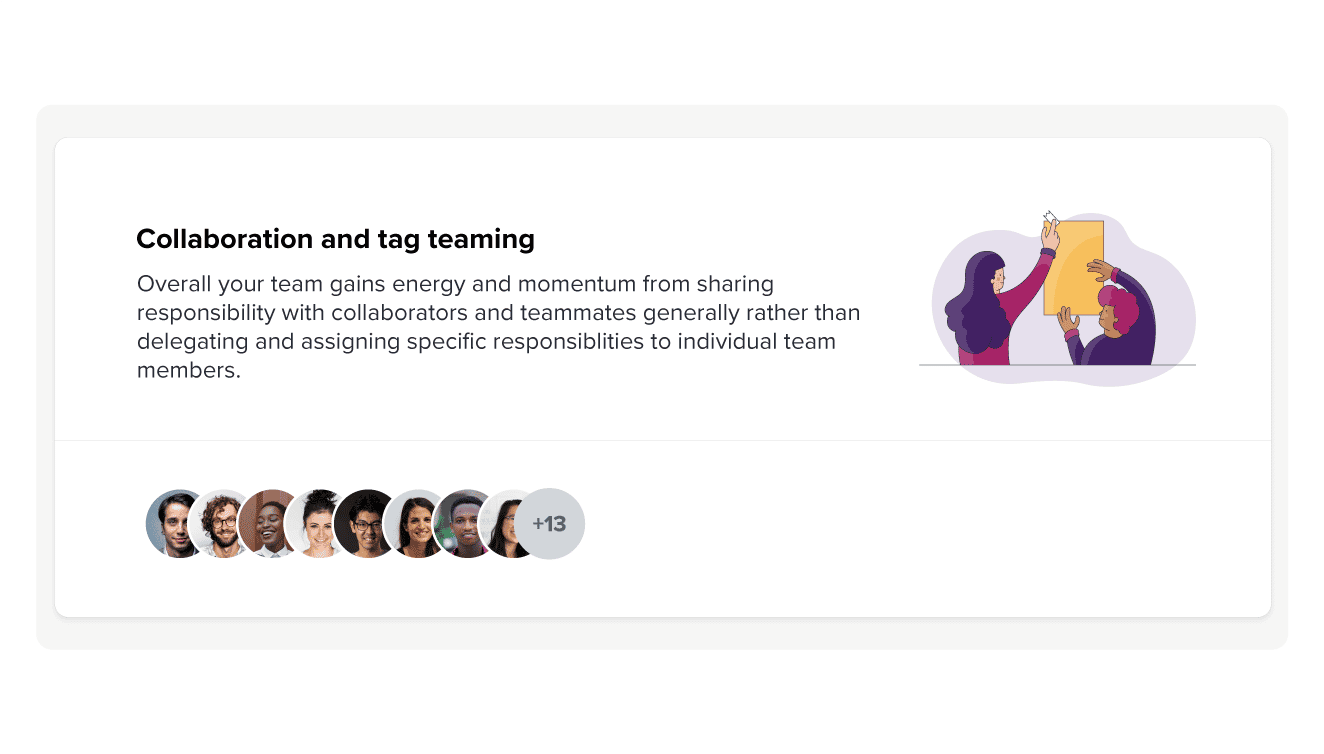How to overcome the most common barriers to communication
You've heard the “communication is key ” cliché, haven't you? There's a reason that sentiment is often repeated. It's true.
A strong communication process is an essential part of any organization. Without effective communication, it can be hard for employees to work well together and find areas of agreement.
When communication breakdowns happen, there is a high chance of confusion between team members. This leads to mistakes, lack of understanding, reduced productivity, and frustrated employees.
Clear communication channels make it easy to understand what each employee should do. It allows teams to interact and provide feedback to one another to keep projects running. This boosts productivity and efficiency at every level of the organization.
Effective communication isn't always easy. In fact, it can be downright hard. One poll of 1,000 employees found that 91% of respondents think their leaders lack this critical skill1.
In order to improve your communication strategy it's crucial to have a common understanding of barriers that stand in your way.
So what are the most common barriers of communication? Keep reading to uncover the most common communication challenges with examples so you and your team can overcome them.
What are the barriers to communication?
We've identified 11 common communication barriers so you can learn how to overcome them in your workplace. These barriers include
- Verbal communication
- Location and physical barriers
- Technology
- Culture
- Motivations
- Organizational structure
- Language, perception
- Interpersonal skills
- Trust
- Gender differences
- Emotional intelligence
Working on these barriers can create a more open and productive communication environment.
How do we overcome barriers?
To overcome barriers it's important to consider that each individual has their own communication preferences and style. For example, if someone is predominantly a hearing style learner, sending them an email or report to read can be a barrier to communication. A better way to engage them is with an audio recording, phone call, or a meeting.

Let’s dig into common communication barriers so you can tackle your ultimate communication goals
Communication barrier #1: Physical barriers
Physical barriers are things that keep people apart, such as closed doors, high cubicle walls, and blocked-off areas. Physical barriers to communication may include distance.
When team members work in different locations, it makes communication harder. A study by Grammarly of US professionals showed that since the pandemic, people use more digital communication channels2. On the other hand, open floor settings can have a lot of background noise that can make it hard for some people to focus.
How to knock them down:
You don't have to change your office layout, but there are ways to help your team work around physical barriers, such as:
- Provide plenty of space for collaboration, as well as quiet spaces for solo work.
- Set ground rules for the different communication mediums on your team. For example, instant messages are for urgent requests, and emails are for status updates and summaries.
- Keep your own office door open to remain approachable. Or set regular office hours where team members can stop by with questions and feedback.
Communication barrier #2: Technological barriers
Technology can either help or hinder your workplace communication. Since most companies are reliant on modern technology, the type of tech you use has a huge impact on your effectiveness of communication.
There is a plethora of collaboration software and messaging apps available these days. Most companies utilize a variety of tools, especially with the rise of remote and hybrid work. Too many tech tools can cause missed messages or a waste of time—especially if they aren't used efficiently. Take a look at our tips and articles on the most popular tech tools for team performance.
Consider accommodating staff by offering a choice of tools that work best for them and their preferred communication devices. Ensure faulty equipment is replaced quickly so no one is slowed down.
How to knock them down:
Don't get frustrated if you experience technological interruptions when communicating with someone. There are tools and tricks that you can use to avoid tech interruptions.
- Give employees proper training on the tools and software your organization uses.
- Provide a wide variety of collaboration and communication tools. Use modern communication technology and document-sharing tools. Examples are, video conferencing tools such as Zoom or Google Meet. Or text-based communication tools such as Slack or iMessage.
- Understand how to manage multicultural teams. Cultural differences can make it hard for people to communicate well through technology.
- Ensure there is access to communication data

Communication barrier #3: cultural barriers
Cultural fit is one of the biggest communication barriers. Diverse teams are more productive, more creative, and more profitable3. But, having employees of different cultural backgrounds also challenges cross-cultural communication. There are different generations, cultures, races, and more. That means they also have differences in communication skills, including different values, work ethics, norms, and preferences.
Cultural barriers to communication may cause employees to feel like they don't fit in the organization. It's tough to communicate effectively with someone when there is no common ground. It is important for your entire workplace to have an internal common language and a core message of respecting cultural differences.
How to knock them down:
Having a team with people from different cultures can make communication hard. But avoiding these differences is not the solution. It's important to find ways to share information despite these cultural barriers to benefit from the diversity of the team. Here are a few ideas:
- Have different forms of communication. These can be guides or “user manuals” that share important information.
- Celebrate the differences on your team with various events and educational opportunities (they're fun, and they boost understanding!).
- Use a people analytics collaboration tool such as F4S to measure each team member's work style and preferred approach to communication. You can even set your location to your geographic region of choice. Then you can implement communication techniques based on your team's preferences. For example, you might find that some of your team prefer affective communication style, meaning they place importance on non-verbal communication and body language. While for those who prefer neutral communication, it is important to provide written and spoken language. Managers who want to be effective communicators will present information in both ways, to eliminate communication obstacles.
- F4S developed a Zoom integration to provide more tools for virtual communication. When you know your colleagues learning preferences, you can share information in the format that suits them. Once you download the Zoom app, answer four questions to find out if you prefer seeing, hearing, doing, or reading/writing. Your top two preferences will show up as emojis on your Zoom screen. Be sure to invite your team to do the same!
Communication barrier #4: Motivational barriers
Simply put, a motivated team is an empowered team—and they're more apt to have a positive attitude.
Motivational barriers come into play when there is a lack of motivation to listen to what someone is saying. It can come from preoccupation or boredom and leads to paying less attention, and poor listening and retention. When this occurs regularly it can result in disengaged workplaces.
Motivational barriers to communication prevent people from sharing information with each other. Low self-esteem, lack of drive, fear of failure, or rejection, are psychological barriers to motivation.
A lack of motivation will make employees believe their opinion is unimportant or there is no incentive to speak up. People require encouragement to initiate conversations about communication challenges.
How to knock them down:
Team morale takes time to build. To improve performance (and overall business performance) you must understand your team's individual motivations. Employees’ individual needs should be acknowledged. By doing so and encouraging good communication, you can boost morale and make everyone feel supported at work. Here are a few ideas:
- Learn about motivation theories. Having a basic understanding of them will help you figure out what drives each team member. The theories can be used to set goals, rewards, expectations, and incentives that will keep them motivated.
- Establish an open and trusting environment where everyone feels comfortable expressing themselves. This helps foster feedback loops that encourages internal communication between coworkers and leaders.
- Using motivational tools in communication encourages employees to take initiative. It gives them the knowledge to make decisions without negative impact.
- Find out what your employees' preferred communication channels are.
One of the best ways to understand your unique team culture is to take the free F4S work style assessment.
Based on more than 20 years of research, it asks a series of questions that measure the 48 distinct work traits that influence the way a person conveys and processes information. F4S uses revolutionary AI-powered technology that improves teamwork and collaboration.
To better understand the communication preferences of your team, invite them to complete the F4S assessment. You’ll gain an understanding of their strengths and preferences - meaning you will know what motivates them and what can be draining. This will show up in your dashboard as Team Affinities and will show how your team generates energy, enjoyment, and flow.

When reviewing team analytics you’ll begin to understand how to communicate most effectively at work. By optimizing team dynamics you can simultaneously increase performance and team morale. With F4S your entire team can become skilled communicators.
Communication barrier #5: Systematic barriers
Systematic barriers make it hard for people in an organization to talk to each other because of how the company is set up or run.
Systematic barriers in communication may include; not having a good way to share information; not teaching good communication skills, or not valuing different perspectives and being afraid to speak up.
These communication obstacles can hurt employee motivation, performance, and the company's success. So, it's important to understand systems thinking to create a successful communication plan.
How to knock them down:
Fixing communication problems caused by organizational barriers is ongoing and needs everyone's effort to be successful. Here's how:
- Make sure everyone knows how to share information to limit communication issues. Have regular meetings and a plan for communication.
- Teach communication skills with F4S's free expert coaching program.
- Value different opinions to make sure everyone feels included.
- Avoid biased language.
- Find out employee's communication preferences.
Communication barrier #6: Language barriers
Language or vocabulary differences can make communication difficult. This can encompass multiple languages or department jargon. Linguistic barriers to communication can be caused by a lack of cultural understanding. It is important to respect different communication styles.
How to knock them down:
If there's a major language difference in your workplace, you'll need to look into translation services to address fundamental communication issues. But here are some other important things to keep in mind:
- Develop successful communication systems for target audiences within the organization.
- Be mindful of jargon and encourage your team members to state things as simply as possible.
- Remember body language too. Different cultures interpret gestures and body language differently. Be aware of your nonverbal communication.
- Create fun content using visuals, demonstrations, and examples where possible. Those can help provide a lot more clarity than written or verbal communication.
- Avoid irrelevant content and unnecessary long-form content
- Segment audiences: adjust communication based on language and culture.
Communication barrier #7: Perceptual barriers

Imagine that you went into a meeting with the assumption that it was going to be a major waste of your time. How inclined are you to listen closely? To engage in the discussion? To actively participate?
Your motivation is probably running pretty low, isn't it? That's a perceptual barrier.
The assumptions we carry with us into exchanges influence our communication style. They can actually hinder our ability to get our point across or result in poor listening. This can create difficult situations for employees.
How to knock them down:
It'd be nice if your own perceptions, biases, and assumptions had a simple “off” switch. While navigating around this barrier isn't quite that easy, these tips can help:
- Support your points with facts and evidence. That type of proof helps to back up your claims, regardless of someone's perceptions.
- View situations from a different perspective, and encourage team members to do the same.
- Ask clarifying questions. These require that you operate based on the information in front of you rather than your assumptions.
Communication barrier #8: Interpersonal communication style barriers
Think of a time when you had to converse with someone who was undeniably stubborn. They insisted that their view was correct, and they refused to listen to any other points of view.
I'm willing to bet that discussion was difficult because you couldn't truly connect with that other person. That's an interpersonal barrier in action.
How to knock them down:
Interpersonal barriers are difficult to overcome. Especially if someone is withdrawn and isn't willing to engage. Here are a few tips that can start to get things back on track:
- Take a deep breath. These situations can be disheartening and frustrating, but escalating emotions won't help.
- Understand how each person communicates so that you can better understand their message. Some people may have an affective communication style. Others may have a neutral communication style. Adjust your future communications to suit each style.
- Improve your self-development with the F4S emotional intelligence coaching program. By learning how to use impactful communication, you can have authentic connections at work and in life.
- Practice active listening techniques to show team members that you value their opinions and ideas. Give others a chance to speak their minds.
Communication barrier #9: Trust barriers
When people at work don't trust each other, it can make it hard for them to work together. Employees may be scared to speak up because they fear they might be ridiculed. When trust is low, it can stop people from being creative and making innovative decisions. To fix this, leaders and employees need to make sure they trust each other and respect each other's ideas.
How to knock them down:
Rebuilding trust in the workplace requires active effort from both leaders and employees. Transparency and teamwork can be improved by ensuring everyone knows what is expected of them, with clearly defined goals. Additionally, consistency from leaders can also foster trust.
- Be open and honest in communication, share information, and answer questions.
- Promote accountability. Employees should be responsible for what they do. And leaders should be responsible for their own decisions.
- Respect others' ideas. Practice listening skills and be consistent and reliable in actions to build trust.
- Lead by example and act ethically to establish trust and create a positive work environment.
Communication barrier #10: Gender barriers
Gender barriers in the workplace can impact the entire workplace. This can include stereotypes and generalizations about gender differences in communication.
Pay attention to communication differences between genders. This will help improve the communication ecosystem in the office.
How to knock them down:
Your best bet is to stay away from generalizations and biased language. Instead, learn more about each of your team members regardless of gender or gender identity. You can do this using the following strategies:
- Provide training on effective communication strategies that take into account potential gender differences.
- Encourage team members to provide feedback to one another.
- Have open conversations about gender bias on your team. Being candid and transparent about those issues is far better than turning a blind eye and pretending they don't exist.
Bonus Communication barrier #11: Emotional barriers
Personality conflicts and emotions can make it hard to communicate effectively. Emotions such as fear, anxiety, or anger often form communication barriers. This can hurt productivity and create a negative communication experience.
How to knock them down:
Emotions are natural, and they shouldn't be discouraged or reprimanded. Instead, you and your team need to understand how to deal with them. Try some of these strategies:
- Know when it's time to walk away.
- Practice naming your emotions. As strange as it can feel to say, “I feel angry” in front of your team, it's actually helpful in diffusing that emotion.
- Having emotional intelligence is important. It involves being aware of your own emotions and those of others, as well as being able to manage them in a healthy way.
What are barriers to nonverbal communication?
Barriers to nonverbal communication can include cultural differences, misinterpretation of gestures or body language, physical obstacles, and emotional states. Understanding and addressing these barriers is essential for effective nonverbal communication in diverse interpersonal interactions.
Furthermore, nonverbal communication refers to someone who emphasizes non-verbal cues such as body language or tone of voice. For someone like this, communication in person or via video chat will be more effective.
How to overcome communication barriers

Effective communication in the workplace is crucial for conveying your core message, but it can be difficult to achieve. To improve communication, be aware of the common barriers mentioned above. Find and understand these barriers to help your team communicate more effectively.
Take it further by inviting your team to take the F4S assessment so you can uncover individual communication preferences, as well as your collective team preferences.
You'll uncover 48 preferences such as:
- verbal or nonverbal communication
- working in a group or a solo environment
- maintaining consistency, making incremental changes, or pioneering new ideas
These preferences are directly related to how well we communicate - and how much we thrive at work. Inspire better communication at work and within your team with F4S' support.
Knock down those communication barriers
Take the free assessment to discover your unique communication style. Then get ready to build your team up by inviting them to join you.
Recommended program for you:
Coach Marlee (your amazing AI-powered personal coach) will analyse your unique traits and goals to personalize the program so you see results as quickly as possible.
Testimonials

“What an awesome way to get better at collaborating with my teammates! Thumbs up Marlee!“

"The changes I made with Marlee, had an immediate impact in the relationship dynamic I was working on in the program"

“The Team Building program was a great tool to get to know my team and to explore how can we improve our way of working”

“Marlee helped me discover skills in myself and about others on how to work together as a team!”

"Marlee really helped me to understand how to cue in on body language and tone when speaking with others, in order to connect on a deeper level"

"This program has helped me to be less impulsive and really think before acting"

“I think Marlee is impressive!”

“I’ve always found it daunting to be a leader, I have never sought out to be the one in charge. The positions have always found me. I now have new confidence. I especially like the concept of leadership through context. Very empowering”.
1. Schwantes, M; August 10, 2017; Survey: 91 Percent of 1,000 Employees Say Their Bosses Lack This 1 Critical Skill; Inc.Australia https://www.inc-aus.com/marcel-schwantes/survey-91-percent-of-1000-employees-say-their-boss.html
2. Grammerly, June 2 2022; Less Casual, More Digital Everything: How Work Communication Has Changed Due to the Pandemic; Grammerly.com; https://www.grammarly.com/blog/pandemic-work-communication-trends/
3 Hunt, Layton, Prince; January 1, 2015; Why Diversity Matters; https://www.fingerprintforsuccess.com/blog/online-collaboration-software
Related Articles
What’s your communication style?
Learn how to connect with colleagues and boost workplace motivation.

Name Surname
Position, Company name

Name Surname
Position, Company name

Name Surname
Position, Company name

Name Surname
Position, Company name

Name Surname
Position, Company name

Name Surname
Position, Company name
Your submission has been received!

Hack your wellbeing, productivity and goals
Programs are created by expert coaches & delivered by our incredible A.I. Coach Marlee. Sessions only take 5-15 minutes and are 100% personalized to fit your unique traits and goals.
